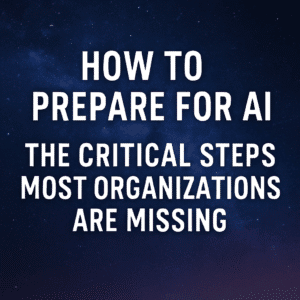Once organizations realize their need to implement new technology, they tend to jump into a digital transformation without covering their bases before they begin. Whether the lack of planning is due to an abundance of excitement or heavy lenience on their system integrator, being unprepared for the transformation will often lead to ERP failure. On the contrary, those who have a full scope implementation plan are the ones who are more likely to optimize their digital transformation and maximize their ROI through the process.
So, what is an implementation plan? Ultimately, it’s everything that will get your software implementation from A to Z. From building and configuring the software to fit your system architecture to the organizational change management tactics and strategies you plan to see through, an implementation plan should illustrate how you will proceed through your digital transformation. It’s your timelines, goals, and governance of the overarching process. Let’s dive into the details of an implementation plan and walk through each component that will guide you through your digital transformation.

Table of Contents
ToggleExecutive Alignment
Just because your executives approved the project does not necessarily mean all parties are aligned. The future state vision starts at the top, and that vision serves as the foundation of any digital transformation. Executives should become crystal clear on the business goals and objectives of the company, and ultimately the purpose of implementing a new software. What’s the end game?
Misalignment is far too often the culprit of trailing performance when it comes to a new software implementation. With that said, executives should focus on the following three things to keep from falling prey to misalignment amongst themselves, and ultimately amongst their greater team.
- Executives should get educated to fully understand what the implementation means and what they should expect. The more realistic view executives can grasp, the better off they will be.
- Executives should establish the guardrails that will keep the project aligned with overarching business goals from start to finish. If the objectives of the project are defined from the beginning, it will help keep the whole executive team and the project team aligned as key decisions need to be made mid-project.
- Executive alignment will need to trickle down to the rest of the organization through proper internal communications. There is a lot that goes into executive alignment, and the risk of misalignment could trickle down into all aspects of the project if the leaders of the organization don’t get ahead of the rhetoric. Communications should start at the beginning of the digital transformation, and communications focus on how everyone will win by going through the new change, from the company as a whole to the individual crunching numbers in accounting.
Until the alignment is there, you would be better off to wait on an implementation.
Define your Processes
Process mapping is a key element to creating an implementation plan. What will your business processes look like with a new technology? What is your target operating model? What is your desired future state and how can technology help you get there? It’s critical that you have a good sense of how your processes flow from start to finish, and how you want them to flow with the implementation of a new software. Once you have this piece dialed in, you can share the vision with a system integrator to bring it to fruition. Create a process map and perform a gap analysis to help you identify where technology can bridge the gap in your current operations.

Focus on the People
You must have a change management strategy in place before diving into a digital transformation project. The concept of organizational change management is often overlooked due to its intangible weight. The problem is, overlooking OCM and failing to plan out an OCM strategy before you jump into a digital transformation are the things that can single-handedly throw your entire implementation off the rails.
Resistance to change is inevitable, regardless of what type of organization you are. The question is, how severe is the resistance and where are the pockets of resistance going to come from? If you do an organizational readiness assessment, you’ll be able to dial in on the biggest areas of risks that your specific company will be up against when it comes to employees adapting to or rejecting the new technology.
Technical Readiness
The capacity to which your IT team is ready will define your company’s ability to handle the new software. Beyond that, your infrastructure will also play a big role in your ability to seamlessly integrate a new system. Is your internal IT department and system architecture ready for a change? Better yet, are they equipped to handle the new needs of your software selection?
These considerations should be addressed in your implementation plan and resolved well before you start your digital transformation journey. The more work you do upfront in planning these pieces, the more money and time you save through the transformation itself trying to figure out the answers mid-way through. Consider questions such as:
- How will the core HCM system tie into the overarching ERP system?
- How are we going to effectively migrate data?
- Is our data clean and ready to be migrated?
- Does our IT department have the right skills in the things we are migrating to?
- Do they need additional training, or will we need to hire new talent?
Are you fully prepared to start the journey?
You are responsible for the outcome of your digital transformation, no one else. Take charge of your own fate by taking ownership of the ins and outs of your software implementation. Yes, you can rely on your system integrator to give you the piece of the puzzle that entails configuring and building technology to fit the need, but nobody knows your company culture, your data, and your overarching business goals like the leaders within your own company. Own it. Govern the project and guide it to the point that the outcome is what you envisioned it to be. Nobody else can do that for you.
Mitigate Risks
Make a list of potential risks you will come across. Maybe it’s resource constraints, maybe it’s a timeline, maybe it’s the anticipated resistance that your team will experience. If you do not identify the potential risks ahead of time, they will sneak up on you and throw your project off balance.
If you would like to discuss or dial in on your implementation plan, please don’t hesitate to reach out to me directly. I am always happy to be an informal sounding board to help get you as prepared as you possibly can be before you venture into the world of digital transformation.





